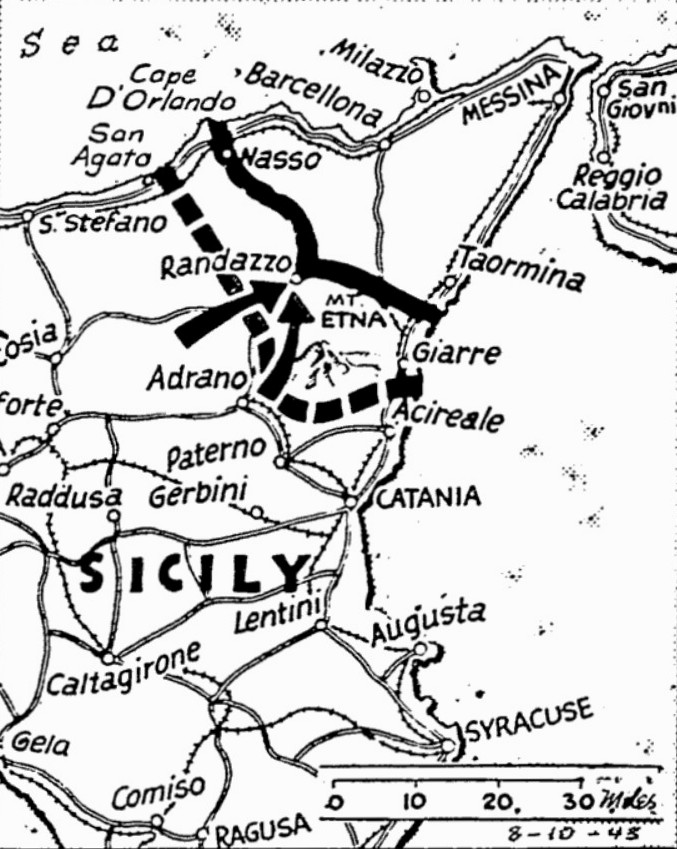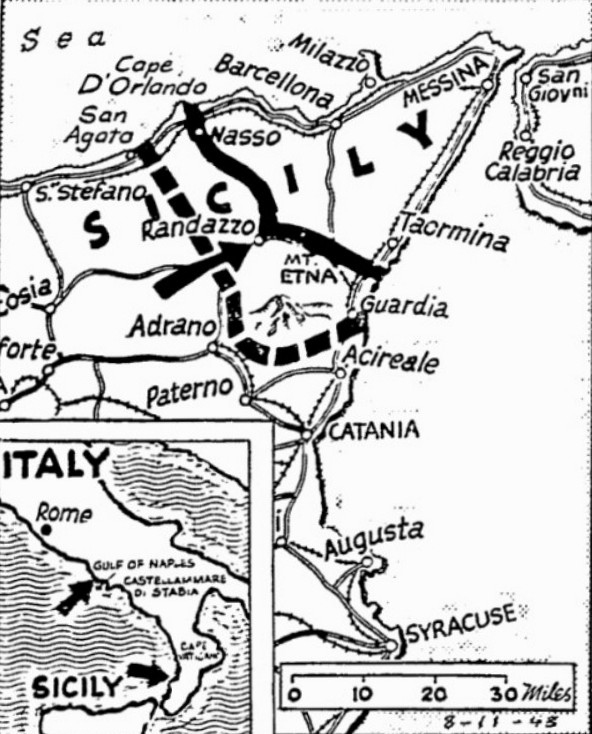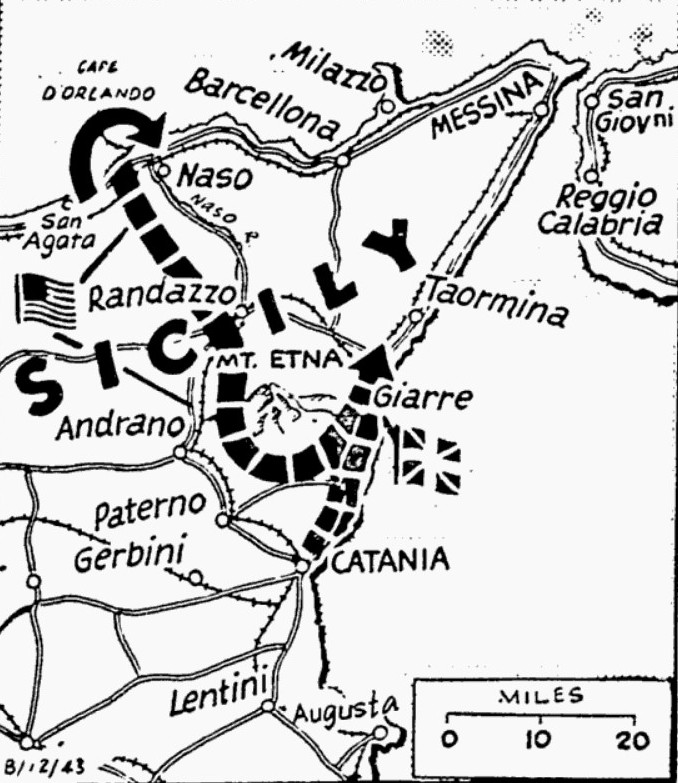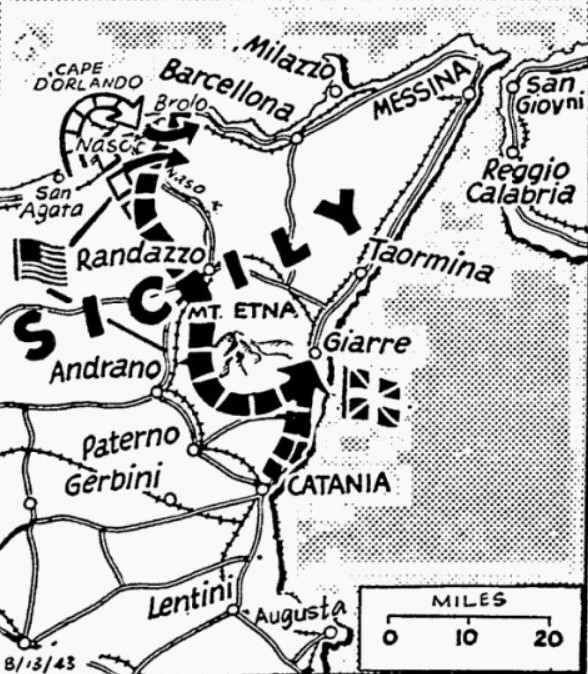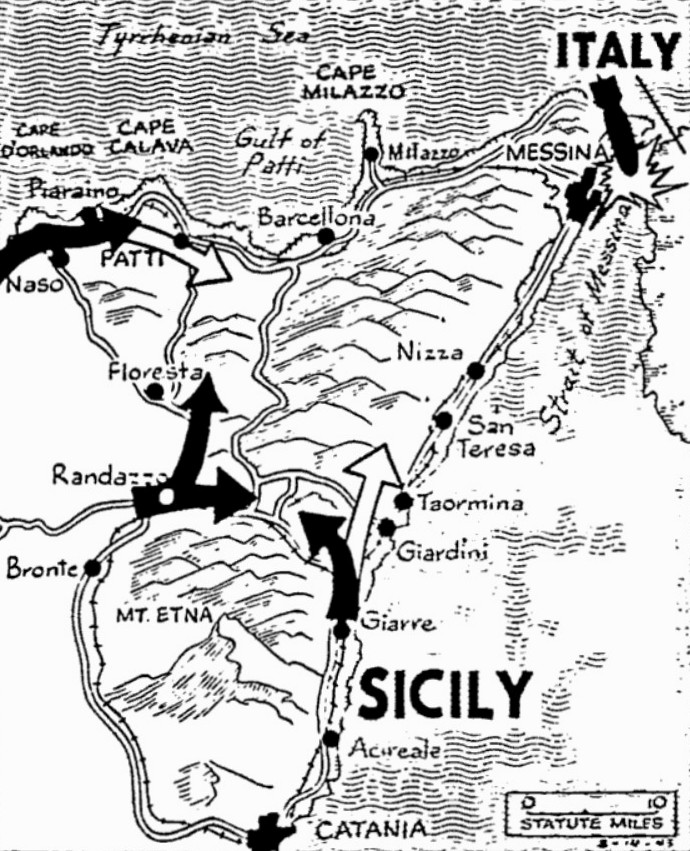The Pittsburgh Press (August 14, 1943)
Allied troops cut off many soldiers in Sicily mountains; planes batter ships evacuating Germans, Italians
By Reynolds Packard, United Press staff writer
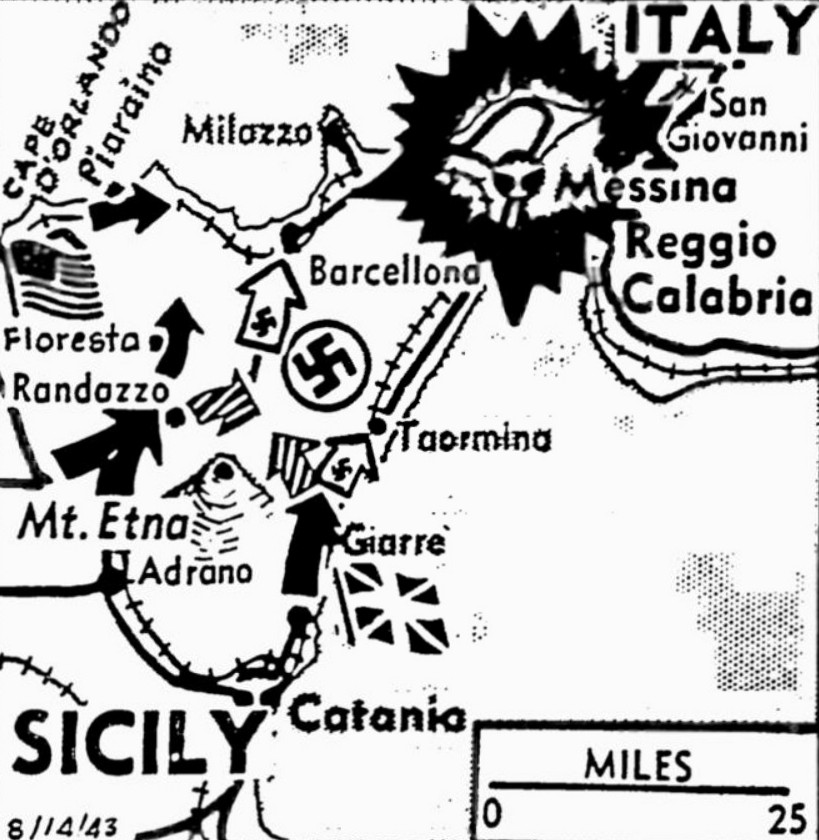
Nearing the end of the trail in Sicily, Axis forces today were streaming across the narrow Strait of Messina as British and U.S. troops closed in. U.S. forces seized Piraino on the north coast. Americans also occupied Floresta in the drive from captured Randazzo, while the British 8th Army thrust around Mt. Etna after capturing Giarre on the east coast. Axis troops were fleeing toward Barcellona and Taormina from the center of the front.
Allied HQ, North Africa –
Axis evacuation of Sicily is in full swing across the Strait of Messina, it was announced today, as the beaten German Army raced to the coast in an effort to escape a deathtrap closed tighter by the capture of five more towns in Allied advances of 2-7 miles.
German troops pulling out of the crumbling Messina bridgehead fled across the narrow three- to 10-mile-wide straits to the Italian mainland under battering attack by Allied planes despite heavy anti-aircraft fire.
Headquarters reports said the trickle of escaping enemy forces had grown to a tide. Every type of boat was pressed into service.
Allied planes sank six small enemy craft off the coast while British motor torpedo boats, slipping into Messina Harbor Wednesday night, torpedoed three merchantmen.
The Allied armies squeezing relentlessly on the faltering Axis lines now dominate all of the Mt. Etna area, it was announced, and may have cut off many enemy troops in the mountains holding rearguard positions.
The Allies speeded up their advance on all fronts, overrunning the Axis rearguard resistance at a pace limited largely by the rugged terrain, as the enemy write-off of the bridgehead became evident from the evacuation.
The wholesale withdrawal under the telling blows of Allied planes and warships collapsed the framework of the Axis defenses everywhere.
The Germans massed many ships and small boats from Italian fishing ports and bathing beaches after the fall of Randazzo, the key to the defense of the island tip, and scrambled for the mainland with every resource at their command.
A-20 Boston assault planes hammered the beaches and railways leading to the beaches. Waves of U.S. and British Warhawk and Kittyhawk fighter-bombers wrecked at least six craft and damaged 16 more.
Wellingtons of the Royal Air Force, taking advantage of the moonlight, went after the troops reaching debarkation points on the mainland beaches.
U.S. troops broke the backbone of Axis resistance yesterday when they charged into Randazzo, mountain town commanding the pass of the same name between Mt. Etna and the Caronian Mountains.
The Germans left the town a mass of flames. It was full of timebombs, which exploded intermittently throughout the day and night. Boobytraps of all kinds were left in and around the town.
Details revealed that Randazzo was taken by a hooking maneuver by which the U.S. Army’s 9th Division entered the town from the west and the British 78th Division from the south.
Allied advances in all sectors in the past 48 hours had won entire regions of the fast-shrinking Axis bridgehead, and the total number of prisoners had increased to between 140,000 and 150,000.
The great bulk of the Axis equipment was being left behind on the Sicilian shores, since the Germans were unable to use any big ships for the dangerous passage between legendary Scylla and Charybdis – the ramparts on either side of the Strait of Messina.
Seizes Floresta
One U.S. column, after consolidating positions in Randazzo, thrust seven miles up the road to Capo d’Orlando and seized Floresta.
The American north coast column advanced two miles from Brolo and captured Piraino, six miles east of Capo d’Orlando, while British forces pounding along the east coast advanced their line three miles along a five-mile front with the capture of Giarre, Riposto and Milo, all 16 miles north of Catania.
Axis line unhinged
Riposto lies on the coast and Giarre and Milo are on a line due west up the slopes of Mt. Etna.
The communiqué reported that the Allies were “steadily pushing” enemy rearguards east from Randazzo, whose capture by the Americans yesterday unhinged the Axis line and split the defenders into two columns racing desperately for Messina and a chance to escape to the Italian mainland.
The thrust through Randazzo left the Axis command in a situation paralleling that in Tunisia following the capture of Tunis and Bizerte, observers said.
Garrison flees
The bulk of the Randazzo garrison was believed fleeing over a tortuous, winding road toward the north coast town of Barcellona, 18 miles west of Messina, or eastward toward Taormina, 28 miles south of Messina.
Allied advances along both coastal roads may close these avenues of escape for the troops in the mountainous interior. The Americans at last reports were some 20 airmiles from Barcellona, while the British 8th Army was only a few miles from Fiumefreddo, some six miles below Taormina.
From Fiumefreddo, the British could slash westward around the northern slopes of Mt. Etna and attack the Germans from the rear.
Front reduced
The capture of Randazzo reduced the Axis front from the north to the east coasts to a mere 30 miles and gave the Allies control of three-quarters of the circumference of Mt. Etna.
The key highway junction fell after some of the fiercest and bloodiest fighting of the Sicilian campaign. Deep minefields protected by machine guns and artillery slowed the advance. Sweating, woolen-clad U.S. troops finally entered the city at 9:35 a.m. yesterday.
Canadian soldiers withdrawn for rest
London, England (UP) –
Canadian military sources indicated today that Dominion troops in Sicily have been withdrawn from the frontlines for a badly-needed rest.
The Canadian units, these sources said, were relieved several days ago after fighting continuously since the initial Allied landing in Sicily, and are now being regrouped in rest areas.
While there has been no official announcement of the move, it was pointed out that the length of the fighting front has been reduced since the juncture of the U.S. 7th and the British 8th Armies in the Mt. Etna area, making it possible for the Canadians to be relieved.
